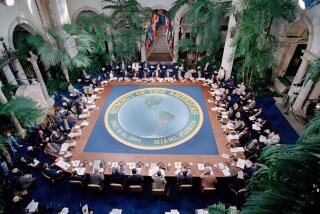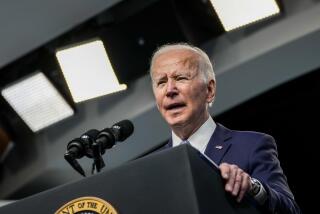THE AD HOC Summit
- Share via
WASHINGTON — The Reykjavik meeting between President Ronald Reagan and Soviet General Secre tary Mikhail S. Gorbachev is a justified exception to the generally sound rule that summit meetings should be carefully prepared and have predictable results. In view of the suddenness of the decision, shortly before the meeting was to occur, and its evident ad hoc and interim nature, there is, fortunately, little public expectation of dramatic results. That being the case, however, the question arises: Was this trip really necessary?
To answer this question, we must begin with the real centerpiece of any summit meeting--the leaders themselves. The unique feature of a summit is the personal engagement and contact of the leaders, in this case Reagan and Gorbachev. There is also something to be said for meetings to permit face-to-face encounter and acquaintance between leaders--that was, of course, the main feature of their initial meeting in Geneva in November, 1985. Indeed, for an ad hoc summit, not a prepared “set piece,” it is important that the leaders already be acquainted, to avoid unpredictable personal chemistry. But why should a preparatory meeting be needed when the two leaders agreed last year at Geneva to schedule two summit meetings in the United States and the Soviet Union in 1986 and 1987? And why in Iceland of all places? Why not meet in Washington if, and when, a meeting is justified? Why meet at all if it is not?
The nub of the matter is that
the diplomatic dialogue, and above all the arms negotiations, have not proceeded as well as envisaged at Geneva. The alternative to Reykjavik may not have been a delayed Washington summit, but none at all. Yet the leaders on both sides clearly want a summit meeting. Moreover, while not yet moving toward agreement on the main issues, some elements in the arms negotiation can be broken out for earlier accord, and--most important--perhaps even the main strategic-arms and space-weapons talks can be rescued. In short, while the arms negotiations do not yet justify a summit, they remain sufficiently promising that both sides have not given up hope of agreement, and by meeting now the leaders hope to stimulate those negotiations. That is the real purpose of the preparatory summit--notwithstanding the broader agenda Reagan will raise.
Reagan and Gorbachev are self-confident men, each with a belief that he is a good communicator, capable of making his position more clear and persuasive in person than in any other way. Moreover,
both are also strongly influenced by personal contact and experience. This is more of a change with respect to the Soviet leadership than the American, but Reagan is
more reliant on his own experience than any other recent President--disdaining the deep immersion in briefings and briefing books avidly sought by John F. Kennedy, the early Richard M. Nixon and Jimmy Carter. Reagan’s reliance on personal experience shows, for example, in his own frequent references to “understanding the communists” based on his own direct experience opposing them in the motion picture labor unions
of Hollywood in the 1940s. Neither Reagan nor Gorbachev is going to be “converted,” or charmed, by the other. But they may both be right that they can better measure the possibilities, and lim
its, on cooperation and arms control through one-on-one discussion than in any other way, and on that basis can provide impetus and direction to the formal negotiations.
Summitry, and such variations as the innovation of a “base camp” pre-summit preparatory meeting of the leaders, are but part of a continuing multifaceted diplomatic dialogue--and one that occurs in the context of a broader and deeper continuing mix of cooperation and competition between the two rival superpowers. Each meeting of leaders is unique in its possibilities and its pitfalls. There are risks in Reykjavik, but not great ones, and the possible gains seem to outweigh them.
For Reagan, Reykjavik is not only a chance to influence Gorbachev and take a personal sounding on the terms of a possible agreement, but a way to reassure the American public on the eve of midterm elections both that his Republican Administration can deal prudently with the Soviets, and that it seeks arms reductions and improved relations. Should the effort later fail, that will become clear only long after the elections (and can always be attributed to Soviet intransigence).
For Gorbachev, the calculation is more complex. While he evidently wants another summit, he has been most reluctant to come to the United States for one without the clear prospect of some concrete achievement in arms control. There is some risk for him in going to Reykjavik, but it is far less than in going to the United States. Moreover, in addition to discussing and perhaps settling on the outline of a limited concrete agreement for the Washington summit, this may be the last chance to move the Geneva negotiations forward so that a major strategic arms accord can be reached within the two years remaining in the Reagan Administration. Contrary to some Western speculation, the Soviet leaders would not hold off from an agreement with the current Administration if one could be reached. And the Soviet leaders, despite the relative newness of some (including Gorbachev himself) to international diplomacy, understand better than Reagan the long lead-time
needed to fashion a major arms-reduction agreement.
Reykjavik may see a closer understanding on one important, but not central, arms-control agreement that could be signed at a Washington summit: a sharp reduction in intermediate-range missiles in Europe. Less likely, but also possible, would be a limited step to curb nuclear testing. Potentially more significant, but also more tentative and elusive, would be progress on a possible later 1987-88 Moscow summit agreement reducing strategic offensive arms and constraining space-weapon testing and deployment. With enough progress at least on the first of these, a firm date in mid-December will probably be announced for Gorbachev’s visit to the United States.
A possible later intermediate-range missile agreement is likely to include reduction from some 850 warheads on about 300 Soviet SS-20 and S-4 missiles facing Europe to 100 (on 33 SS-20 launchers), and from the planned total of 562 warheads on U.S. missiles to 100 (possibly all ground-launched cruise missiles, possibly including 27 or 36 Pershing 2 ballistic missiles, on 100 launchers). The Soviet Union would also limit and reduce somewhat its 513 warheads on 171 SS-20s in Asia, and the United States might retain a right to a comparable number held in the United States. A freeze, and perhaps reduction, would probably also be made in 500-mile range S-12/22 missile launchers moved forward in 1984 into East Germany and Czechoslovakia in response to the U.S. missile deployments. Destruction of the intermediate missile systems withdrawn would be verified, perhaps with “on site” observation, and measures easing future verification would be provided to assure against exceeding allowed levels.
In the nuclear testing area, the Soviet leaders will continue to press for a comprehensive test ban, but are probably reconciled to Reagan’s rejection of it. Some time after Reykjavik, the Soviet Union could announce new cooperative verification measures, after which Reagan would announce that, with this additional verification, he is prepared to request that the Senate ratify the Threshold Test Ban Treaty signed by Nixon in 1974, and the Peaceful Nuclear Explosions Treaty signed by President Gerald R. Ford in 1976. Talks might then be opened on ways to extend constraints on nuclear testing, perhaps setting a quota on the number of tests per year (say, 10) and gradually reducing the threshold limit from 150 to, say, 75 or 100 kilotons yield. Formal agreement would, however, probably await the next summit.
The meeting in Reykjavik has come about only because the two leaders want a real summit, and saw a preparatory meeting as necessary. It is, therefore, not likely to fail. Its only concrete accomplishment may be setting a firm date for Gorbachev’s visit to the United States. Whether it will really succeed may not, however, be clear for some time. Continued attention and direction by Reagan will be necessary to ensure that arms negotiations remain on track even for the limited agreements now in view. Progress in the more difficult, and more important, strategic and space-arms talks will require still greater efforts and substantial compromise by both sides. Reykjavik will buy time and keep the possibility open, but the real work now only begins.
More to Read
Sign up for Essential California
The most important California stories and recommendations in your inbox every morning.
You may occasionally receive promotional content from the Los Angeles Times.












